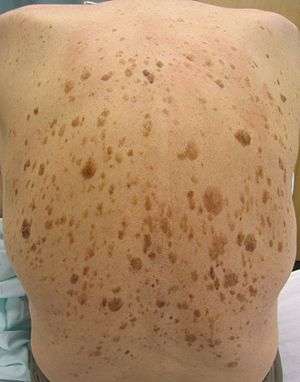Leser–Trélat sign

The Leser-Trélat sign is the explosive onset of multiple seborrheic keratoses[1] (many pigmented skin lesions),[2][3] often with an inflammatory base. This can be an ominous sign of internal malignancy as part of a paraneoplastic syndrome. In addition to the development of new lesions, preexisting ones frequently increase in size and become symptomatic.
History
It is named for Edmund Leser and Ulysse Trélat.[4][5]
It has been suggested that Leser and Trélat were observing angiomas and not seborrheic keratoses, and so the credit should properly go to Hollander for his 1900 publication.[6][7][8]
Associations
Although most associated neoplasms are gastrointestinal[9] adenocarcinomas (stomach, liver, colorectal and pancreas), malignancies of the breast, lung,[10] and urinary tract,[11] as well as lymphoid tissue, have been associated with this impressive rash. It is likely that various cytokines and other growth factors produced by the neoplasm are responsible for the abrupt appearance of the seborrheic keratoses.
In some cases, paraneoplastic acanthosis nigricans (35% of patients), florid cutaneous papillomatosis, ichthyosis acquisita (acquired hypertrichosis lanuginosa), Cowden syndrome, tylosis, acrokeratosis paraneoplastica of Bazex and tripe palms accompanies the sign of Leser-Trélat.
References
- ↑ Schwartz RA (July 1996). "Sign of Leser-Trélat". J. Am. Acad. Dermatol. 35 (1): 88–95. PMID 8682971. doi:10.1016/S0190-9622(96)90502-2.
- ↑ Odom, Richard B.; Davidsohn, Israel; James, William D.; Henry, John Bernard; Berger, Timothy G.; Clinical diagnosis by laboratory methods; Dirk M. Elston (2006). Andrews' diseases of the skin: clinical dermatology. Saunders Elsevier. p. 638. ISBN 0-7216-2921-0.
- ↑ "eMedicine - Sign of Leser-Trelat : Article by Robert A Schwartz".
- ↑ synd/3211 at Who Named It?
- ↑ Leser E. Ueber ein die Krebskrankheit beim Menschen haufig begleitendes, noch wenig gekanntes Symptom. Munchener Med Wochenschr. 1901;51:2035-2036.
- ↑ "Sign of Leser-Trelat". Retrieved 15 July 2011.
- ↑ Hollander E. V. Beitrage zur Fruhdiagnose des Darmcarcinomas (Hereditatsverhaltnisse und Hautveranderungen. Deutsche Medicinische Wochenschrift. 1900;26:483-485.
- ↑ Lock, Stephen; Last, John M.; Dunea, George (2001-12-01). The Oxford illustrated companion to medicine. Oxford University Press US. pp. 502–. ISBN 978-0-19-262950-0. Retrieved 15 July 2011.
- ↑ Gregory B, Ho VC (February 1992). "Cutaneous manifestations of gastrointestinal disorders. Part I". J. Am. Acad. Dermatol. 26 (2 Pt 1): 153–66. PMID 1552046. doi:10.1016/0190-9622(92)70019-C.
- ↑ Heaphy MR, Millns JL, Schroeter AL (August 2000). "The sign of Leser-Trélat in a case of adenocarcinoma of the lung". J. Am. Acad. Dermatol. 43 (2 Pt 2): 386–90. PMID 10901731. doi:10.1016/S0190-9622(00)70301-X.
- ↑ Yaniv R, Servadio Y, Feinstein A, Trau H (March 1994). "The sign of Leser-Trélat associated with transitional cell carcinoma of the urinary-bladder--a case report and short review". Clin. Exp. Dermatol. 19 (2): 142–5. PMID 8050144. doi:10.1111/j.1365-2230.1994.tb01143.x.
External links
- New Zealand Dermatological Society Includes images